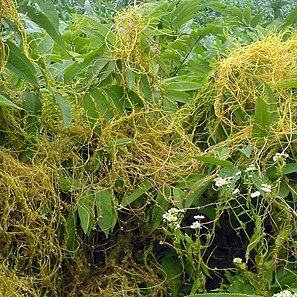Herbs parasitic, yellow or reddish, glabrous. Stems twining, filiform, obtaining nourishment from hosts by haustoria. Leaves reduced to minute scales. Flowers sessile or short pedicellate, mostly in globular, spicate, racemose, or cymose clusters, 4-or 5-merous; bracts minute or absent. Calyx gamosepalous, ± deeply lobed, or sepals free. Corolla white, pinkish, or cream colored, urceolate, tubular, globose or campanulate, inside with fimbriate or crenulate, membranous, infrastaminal scales at base of tube. Stamens as many as corolla lobes, inserted on corolla above scales, alternating with corolla lobes. Pollen smooth. Ovary 2-loculed; ovules 2 per locule. Styles 1 or 2; stigmas 2, subglobose or elongated, sometimes united. Capsule ovoid or globose, dry or sometimes fleshy, circumscissile or opening irregularly. Seeds 1-4, glabrous; embryo acotyledonous, filiform spiral-curved.
Annual or perennial herbaceous rootless parasites with thread-like twining stems bearing haustoria and lacking chlorophyll or latex, often forming a dense mass on the host plant. Lvs reduced to minute scales. Infl. cymose, umbellate, capitate or spike-like. Fls small, white to pink or yellowish. Calyx (3)-4-5-lobed, occasionally with free sepals. Corolla (3)-4-5-lobed, usually urceolate, campanulate or ± globose; lobes imbricate. Stamens inserted in throat of corolla, with lobed or fimbriate scales between the stamens; anthers very short. Ovary 2-locular, sometimes incompletely so; each loculus with 2 ovules. Styles 2, free or connate. Fr. a globose or ovoid capsule, dry or ± fleshy, dehiscing transversely or by an irregular split, 1-4-seeded. Seeds glabrous, with filiform embryo surrounding the endosperm. Cotyledons rudimentary or 0.
Herbaceous parasites with slender, often filiform, twining, yellow or reddish stems, with haustoria. Leaves reduced to minute scales. Flowers small, mostly in cymose clusters, 5-, rarely 4-or 3-merous. Calyx more or less deeply lobed, or consisting of free sepals. Corolla tubular, urceolate, globose or campanulate; the tube with crenulate or fimbriate episepalous scales inside. Stamens as many as corolla-lobes, inserted on the corolla above the scales; pollen ellipsoid, smooth. Ovary 2-celled, each cell with 2 ovules. Styles 2, distinct, or 1; stigmas globose, subglobose or elongated. Fruit an ovoid or globose, dry or fleshy capsule, opening irregularly, circumscissile, or remaining closed. Seeds 4 or less, glabrous; embryo acotyledonous, filiform, enlarged at one end.
Vines without chlorophyll; the stems twining, filiform, yellow or orange or rarely greenish, attached to host plants by haustoria; roots withering and absent from mature plants. Leaves reduced to minute scales. Inflorescences cymose, composed of small whitish flowers; calyx gamosepalous, 5-lobed, the sepals rarely almost free; corolla urceolate or campanulate, the 5 lobes various, usually with basal scale-like appendages inside opposite the stamens, forming a corona; the pollen 3-colpate; ovary 2-locular, locules biovulate, styles 2, distinct or rarely united, terminal, the stigmas capitate to linear. Fruit capsular or circumscissle near the base; the seeds (1-3)-4, smooth or roughened.
Fls small, us. bracted, 5-(4)-merous, in cymose clusters; sepals mostly united at base; stamens alt. with corolla-lobes, inserted at throat. Corolla urceolate to campanulate; staminal filaments each with fringed scale at base; ovary 2-loculed, 2-ovuled; styles distinct. Capsule ± circumscissile, embryo filiform. Parasitic annual herbs with filiform twining stems attached to host by haustoria; lvs minute, scalelike. Widespread genus with over 160 spp.
Characters of the family. 100, cosmop. (Grammica) Our spp. bloom in late summer; most have a wide range of hosts.

